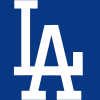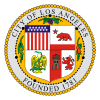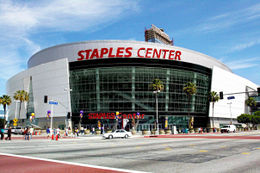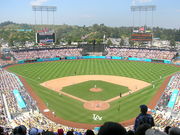Los Angeles Dodgers
| Los Angeles Dodgers | |||
|---|---|---|---|
| Established | 1883 | ||
| Based in Los Angeles since 1958 | |||
|
|||
| Major league affiliations | |||
|
|||
| Current uniform | |||
|
|||
| Retired numbers | 1, 2, 4, 19, 20, 24, 32, 39, 42, 53 | ||
| Colors | |||
|
|||
| Name | |||
|
|||
(1932 is the first year in which the nickname appeared on the uniforms of the Brooklyn Base Ball Club.) |
|||
| Other nicknames | |||
|
|||
| Ballpark | |||
|
|||
| Major league titles | |||
| World Series titles (6) | 1988 • 1981 • 1965 • 1963 1959 • 1955 |
||
| NL Pennants (21) | 1988 • 1981 • 1978 • 1977 1974 • 1966 • 1965 • 1963 1959 • 1956 • 1955 • 1953 1952 • 1949 • 1947 • 1941 1920 • 1916 • 1900 • 1899 1890 |
||
| AA Pennants (1) | 1889 | ||
| West Division titles (11) [1][2] | 2009 • 2008 • 2004 • 1995 • 1988 • 1985 1983 • 1981 • 1978 • 1977 1974 |
||
| Wild card berths (2) | 2006 • 1996 | ||
|
[1] - In 1981, a players' strike in the middle of the season forced the season to be split into two halves. Los Angeles had the best record in the West Division when play was stopped and was declared the first-half division winner. The Dodgers had the second best record in the division when considering the entire season, four games behind Cincinnati. |
|||
| Owner(s): Frank McCourt | |||
| Manager: Joe Torre | |||
| General Manager: Ned Colletti | |||
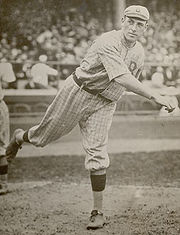
The Los Angeles Dodgers are a Major League Baseball team based in Los Angeles, California, USA. The team is in the Western Division of the National League. Established in 1883, the team originated in Brooklyn, New York, where it was known by a number of nicknames before becoming the Dodgers definitively by the 1932 season.[1][2] The team moved to Los Angeles before the 1958 season.[3] The Dodgers are the two-time reigning National League West champions and have won more National League pennants (21) than any team in history, with ten West division titles, and two Wild Card appearances. They have appeared in 18 World Series, more than any other NL team, and have won six times.
Contents |
Team history
Brooklyn Dodgers
The Dodgers were originally founded in 1883 as the Brooklyn Atlantics, taking the name of a defunct team that had played in Brooklyn prior to them. The team joined the American Association in 1884 and won the AA championship in 1889 before joining the National League in 1890. They promptly won the NL Championship their first year in the League. The team was known alternatively as the Bridegrooms, Grooms, Superbas, Robins, and Trolley Dodgers before officially becoming the Dodgers in the 1930s.
In Brooklyn, the Dodgers won the NL pennant several times (1890, 1899, 1900, 1916, 1920, 1941, 1947, 1949, 1952, 1953, 1955 1956) and the World Series in 1955. After moving to Los Angeles, the team won World Series championships in 1959, 1963, 1965, 1981, 1988. Altogether, the Dodgers have appeared in 18 World Series.
Jackie Robinson
For most of the first half of the 20th century, no Major League Baseball team employed an African American player. Jackie Robinson became the first African American to play for a Major League Baseball team when he played his first major league game on April 15, 1947, as a member of the Brooklyn Dodgers. It happened mainly due to General Manager Branch Rickey's efforts. The deeply religious Rickey's motivation appears to have been primarily moral, although business considerations were also present. Rickey was a member of The Methodist Church, the antecedent denomination to The United Methodist Church of today, which was a strong advocate for social justice and active later in the Civil Rights movement.[4]
This event was the harbinger of the integration of professional sports in the United States, the concomitant demise of the Negro Leagues, and is regarded as a key moment in the history of the American Civil Rights movement. Robinson was an exceptional player, a speedy runner who sparked the team with his intensity. He was the inaugural recipient of the Rookie of the Year award, which is now named the Jackie Robinson award in his honor. The Dodgers' willingness to integrate, when most other teams refused to, was a key factor in their 1947–1956 success. They won six pennants in those 10 years with the help of Robinson, three-time MVP Roy Campanella, Cy Young Award winner Don Newcombe, Jim Gilliam, and Joe Black. Robinson would eventually go on to become the first African-American elected to the Baseball Hall of Fame in 1962.
In 1955, by which time the core of the Dodger team was beginning to age, “next year” finally came. The fabled “Boys of Summer” shot down the "Bronx Bombers" in seven games, led by the first-class pitching of young left-hander Johnny Podres, whose key pitch was a changeup known as “pulling down the lampshade” because of the arm motion used right when the ball was released.[5] Podres won two Series games, including the deciding seventh. The turning point of Game 7 was a spectacular double play that began with left fielder Sandy Amoros running down Yogi Berra’s long fly ball, then throwing to shortstop Pee Wee Reese, who doubled up a surprised Gil McDougald at first base to preserve the Dodger lead. The Dodgers won 2–0.
Move to Los Angeles
Real estate businessman Walter O'Malley had acquired majority ownership of the Dodgers in 1950, when he bought the shares of his co-owners, the estate of Branch Rickey and the late John L. Smith. Before long he was working to buy new land in Brooklyn to build a more accessible and better arrayed ballpark than Ebbets Field. Beloved as it was, Ebbets Field had grown old and was not well served by infrastructure, to the point where the Dodgers could not sell the park out even in the heat of a pennant race (despite largely dominating the league from 1946 to 1957).
O'Malley wanted to build a new, state of the art stadium in Brooklyn. But City Planner Robert Moses and other New York politicians refused to let him build the Brooklyn stadium he wanted. During the 1955 season he announced that the team would play seven regular season games and one exhibition game at Jersey City’s Roosevelt Stadium in 1956. He expected that this move would put pressure on the city's politicians to build the Dodgers the park he wanted in Brooklyn.[6] Yet Moses and the others considered this an empty threat, and did not believe O'Malley would go through with moving the team from New York City. That is when Los Angeles came into the picture.
When Los Angeles officials attended the 1956 World Series looking to entice a team to move to the City of Angels, they were not even considering the Dodgers. Their original target had been the Washington Senators (who would in fact move to Bloomington, suburban Minneapolis, to become the Minnesota Twins in 1961). When O'Malley heard that LA was looking for a club, he sent word to the Los Angeles officials that he was interested in talking. Los Angeles offered him what New York would not: a chance to buy land suitable for building a ballpark, and own that ballpark, giving him complete control over all its revenue streams. When the news came out, Mayor Robert F. Wagner, Jr. and Moses made a feeble effort to save the Dodgers, offering to build a ballpark on the World's Fair Grounds in Queens. Wagner was already on shaky ground, as the Giants were getting ready to move out of the crumbling Polo Grounds. However, O'Malley was interested in his park only under his conditions, and the plans for a new stadium in Brooklyn seemed like a pipe dream. Walter O'Malley was left with the difficult decision to move the Dodgers to California, convincing Giants owner Horace Stoneham to move to San Francisco instead of Minneapolis to keep the Giants-Dodgers rivalry alive on the West Coast. There was no turning back: the Dodgers were heading for Hollywood.[6]
The Dodgers played their final game at Ebbets Field on September 24, 1957, which the Dodgers won 2–0 over the Pittsburgh Pirates.
Los Angeles Dodgers
On April 18, 1958, the Los Angeles Dodgers played their first game in LA, defeating the former New York and now new San Francisco Giants, 6–5, before 78,672 fans at the Los Angeles Memorial Coliseum. Sadly, catcher Roy Campanella, left partially paralyzed in an off-season accident, was never able to play for Los Angeles.
Construction on Dodger Stadium was completed in time for Opening Day 1962. With its clean, simple lines and its picturesque setting amid hills and palm trees, the ballpark quickly became an icon of the Dodgers and their new California lifestyle, and it remains one of the most highly-regarded stadiums in baseball even today. Despite the fact that the Dodgers have played in Dodger Stadium longer than they had played in Ebbetts Field, the stadium remains surprisingly fresh. O'Malley was determined that there would not be a bad seat in the house, achieving this by cantilevered grandstands that have since been widely imitated. More importantly for the team, the stadium's spacious dimensions, along with other factors, gave defense an advantage over offense, and the Dodgers moved to take advantage of this by assembling a team that would excel with its pitching.
The Dodgers in Los Angeles won nine more National League Championships and five World Series rings.
Other historical notes
Historical statistics
- First MLB team to employ and start a black player in the 20th century (Jackie Robinson in 1947)
- First baseball team to win championships in different leagues in consecutive years (1889–1890)
- First TV broadcast (1939)
- First use of batting helmets (1941)
- First West Coast team (1958) - along with the San Francisco Giants
- First MLB team to open an office in Asia (1998)
- Largest home-opener crowd (78,762 in 1958)
- Largest attendance: 93,103 (1959) and 115,300 (2008) *World Record
- MLB record for home start going 13-0 (2009)
The team's nickname
By 1890 New Yorkers (Brooklyn was a separate city until it became a borough in 1898) routinely called anyone from Brooklyn a "trolley dodger," due to the vast network of street car lines criss-crossing the borough as people dodged trains to play on the streets. When the second Washington Park burned down early in the 1891 season, the team moved to nearby Eastern Park, which was bordered on two sides by street car tracks. That's when the team was first called the Brooklyn Trolley Dodgers. That was soon shortened to Dodgers.[7] Possibly because of the "street character" nature of Jack Dawkins, the "Artful Dodger" in Charles Dickens' Oliver Twist, sportswriters in the early 20th Century began referring to the Dodgers as the "Bums."
Other team names used by the franchise which would finally be called the Dodgers were the Atlantics, Grays, Grooms, the Bridegrooms, the Superbas and the Robins. All of these nicknames were used by fans and sportswriters to describe the team, but not in any official capacity. The team's legal name was the Brooklyn Base Ball Club.[8] However, the Trolley Dodger nickname was used throughout this period, simultaneously with these other nicknames, by fans and sportswriters of the day. The team did not use the name in any formal sense until 1932, when the word "Dodgers" appeared on jerseys for the team.[1] The "conclusive shift" came in 1933, when both home and road jerseys for the team bore the name "Dodgers".[2]
Examples of how the many popularized names of the team were used are available from newspaper articles from the period before 1932. A New York Times article describing a game the Dodgers played in 1916 starts out by referring to how "Jimmy Callahan, pilot of the Pirates, did his best to wreck the hopes the Dodgers have of gaining the National League pennant", but then goes on to comment "the only thing that saved the Superbas from being toppled from first place was that the Phillies lost one of the two games played".[9] What is interesting about the use of these two nicknames is that most baseball statistics sites and baseball historians generally now refer to the pennant-winning 1916 Brooklyn team as the Robins. A 1918 New York Times article does use the nickname Robins in its title "Buccaneers Take Last From Robins", but the subtitle of the article reads "Subdue The Superbas By 11 To 4, Making Series An Even Break".[10]
Another example of the fluidity of use of the different nicknames is found on the program issued at Ebbetts Field for the 1920 World Series, which identifies the matchup in the series as "Dodgers vs. Indians", despite the fact that the Robins nickname had been in consistent usage at this point for around six years.[11]
Rivalry with the San Francisco Giants
The historic rivalry between the San Francisco Giants and the Dodgers is the longest standing and most storied in baseball history. The rivalry began when these two National League clubs both played in New York City (the Giants at the Polo Grounds in Manhattan and the Dodgers at Ebbets Field in Brooklyn). Both franchises date back to the nineteenth century, and both moved to California in 1958, where the rivalry found a fitting new home. The cities of Los Angeles and San Francisco having long been rivals in economic, cultural, and political arenas. Although the feud between the Boston Red Sox and the New York Yankees gets more publicity, the Dodgers/Giants rivalry is the oldest in baseball. The Giants have won the World Series five times in their history, while the Dodgers have won the World Series six times. Since historically, the playoff race in the NL West has been fairly tight, the feud often leads to one team spoiling the others chances of any hopeful playoff spot. An example of this phenomenon was in the 1951 season, where the New York Giants and the Brooklyn Dodgers faced off in a three game playoff. Supported by Bobby Thomson's Shot Heard 'Round the World, the Giants won the game 5-4, defeating the Dodgers in their pennant playoff series, two games to one. Another more recent example played out in the 2004 season when the Dodgers beat out the Giants for the NL West by two games after Steve Finley broke a 3-3 tie, by hitting a walk-off Grand Slam in the bottom of the 9th inning, in the second-to-last game of the regular season, thus sealing the division for the Dodgers. Unlike other historic rivalries such as those between the Cardinals and Cubs and the Red Sox and Yankees, the rivalry between the Dodgers and Giants has been very even, with both teams experiencing success over the years.
Uniforms
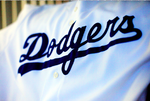
The Dodgers uniforms have remained relatively unchanged for almost 70 years. The home jersey is white with Dodgers written in script across the chest in blue. The word Dodgers was first used on the front of the team's home jersey in 1933, and the uniform was white with red pinstripes and the Brooklyn stylized B on the left shoulder.[12] The Dodgers also wore green outlined uniforms and green caps throughout the 1937 season but reverted to a blue template the following year. Since 1952 the team has had a red uniform number under the Dodgers script. The road jersey is gray with Los Angeles written in script across the chest in blue. The road jerseys also have a red uniform number under the script. The Dodgers have worn the current uniforms on the field since 1939 with only minor cosmetic changes. The most obvious of these is the removal of "Brooklyn" from the road jerseys and the replacement of the stylized "B" with the interlocking "L.A." on the caps in 1958. In 1970 the Dodgers removed the city name from the road jerseys and had Dodgers on both the home and away uniforms. The city script returned to the road jerseys in 1999. Also in 1999 the tradition rich Dodgers flirted with an alternate uniform for the first time since 1944 (when all blue satin uniforms were introduced). These 1999 alternate jerseys had a royal blue top with the Dodgers script in white across the chest and the red number on the front. These were worn with white pants and a new Dodger cap complete with a silver brim, silver top button and silver Dodger logo. These alternates proved unpopular and the team abandoned them after only one season just as they did 55 years earlier with the blue satin uniforms.
Asian players
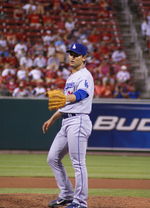
The Dodgers have been groundbreaking in their signing of players from Asia; namely, Japan, Korea, and Taiwan. Former owner Peter O'Malley began reaching out in 1980 by starting clinics in China and Korea, building baseball fields in two Chinese cities, and in 1998 becoming the first major league team to open an office in Asia. The Dodgers were the second team to start a Japanese player in recent history, pitcher Hideo Nomo, the first team to start a Korean player, pitcher Chan Ho Park, and the first Taiwanese player, Chin-Feng Chen. In addition, they were the first team to send out three Asian pitchers, from different Asian countries, in one game: Park, Hong-Chih Kuo of Taiwan, and Takashi Saito of Japan. In the 2008 season the Dodgers had the most Asian players on its roster of any major league team with five. They included Japanese pitchers Takashi Saito and Hiroki Kuroda; Korean pitcher Chan Ho Park; and Taiwanese pitcher Hong-Chih Kuo and infielder Chin-Lung Hu. Furthermore in 2005, the Dodgers' Hee Seop Choi became the first Asian player to compete in the Home Run Derby. [13]
Fan support

The Dodgers have a fiercely loyal fanbase, evidenced by the fact that the Dodgers were the first MLB team to attract more than 3 million fans in a season (in 1978), and accomplished that feat 6 more times before any other franchise did it once.[14] On July 3, 2007, Dodgers management announced that total franchise attendance, dating back to 1901, had reached 175 million, a record for all professional sports.[15] In 2009 the Dodgers led the MLB in total attendance.[16] Given the team's proximity to Hollywood, numerous celebrities can often be seen attending home games at Dodger Stadium.
The Dodgers also recently set the world record for the greatest attendance for a single baseball game during an exhibition game against the Boston Red Sox at the Los Angeles Memorial Coliseum in honor of the Dodgers 50th anniversary in Los Angeles with over 115,000 fans in attendance. All proceeds from the game benefitted the official charity of the Dodgers, ThinkCure! which supports cancer research at Children's Hospital Los Angeles, and City of Hope.
Radio and television
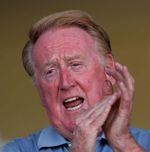
Vin Scully has called Dodgers games since 1950.[17] His longtime partners were Jerry Doggett (1956–1987) and Ross Porter (1977–2004).[17] In 1976, he was selected by Dodgers fans as the Most Memorable Personality (on the field or off) in the team's history. He is also a recipient of the Baseball Hall of Fame's Ford C. Frick Award for broadcasters (inducted in 1982). He currently is in his 60th year with the team. Unlike the modern style in which multiple sportscasters have an on-air conversation (usually with one functioning as play-by-play announcer and the other(s) as color commentator), Scully, Doggett and Porter generally called games solo, trading with each other inning-by-inning. In the 1980s and 90s, Scully would call the entire radio broadcast except for the 3rd and 7th inning; allowing the other Dodger commentators to broadcast an inning.
When Doggett retired after the 1987 season, he was replaced by Hall-of-Fame Dodgers pitcher Don Drysdale, who previously broadcast games for the crosstown California Angels.[17] Drysdale died in his hotel room following a heart attack before a game in 1993, resulting in a very difficult broadcast for Scully and Porter, who were told of the death but could not mention it on-air until Drysdale's family had been notified and the official announcement of the death made.[18] He was replaced by former Dodgers outfielder Rick Monday.[17] Porter's tenure was terminated somewhat controversially after the 2004 season, after which the current format of play-by-play announcers and color commentators was installed, led by newcomer Charley Steiner as well as Scully and Monday.[17]
Today, Scully calls a limited schedule of games (all home games and road games in NL West ballparks) for both flagship radio station KABC and television outlets KCAL-TV and Prime Ticket. Scully is simulcast for the first three innings of each of his appearances, then announces only for the TV audience.
If Scully is calling the game, Charley Steiner takes over play-by-play on radio beginning with the fourth inning, with Rick Monday as color commentator. If Scully is not calling the game, Eric Collins and Steve Lyons call the entire game on television while Steiner and Monday do the same on radio.
In the event the Dodgers are in post-season play, Scully calls the first three and last three innings of the radio broadcast alone; with Charley Steiner and Rick Monday handling the middle innings.
The Dodgers also broadcast on radio in Spanish, and the play-by-play is handled by another Ford C. Frick Award winner, Jaime Jarrin. Jarrin has been with the Dodgers since 1959. The color analyst for some games is former Dodger pitcher Fernando Valenzuela, for whom Jarrin once translated post-game interviews. The Spanish-language flagship is KHJ.
Live traffic reports pertaining to Dodger Stadium are broadcast from the Dodgers Transportation Center inside the ballpark. KABC radio's Captain Jorge Jarrin (son of Dodger broadcaster Jaime Jarrin) and Doug Dunlap handle those duties during the pre-game and post-game shows as well as during Dodger Talk following the game.
In 2006, the Dodgers introduced an on demand channel on Time Warner Cable called "Dodgers on Demand", hosted by Tony Kinkela.
Currently, Steiner has been converted to radio-only with Rick Monday.[19] Jerry Reuss was removed from his broadcast position, though he is still with the club to serve in other aspects.[19] Steve Lyons will be retained as a color-commentator, and the Dodgers recently hired ESPN broadcaster Eric Collins as a play-by-play announcer to replace Steiner on road games for television.[19]
Dodgers games are also aired on former flagship KTTV Channel 11 as part of the Major League Baseball on Fox package, as well as on ESPN and TBS. KTTV was the flagship station of the Dodgers during the team's first 36 seasons in Los Angeles.
Quick facts
- Founded: November 24, 1883 and began playing in 1884 as the Brooklyn Atlantics (different from an earlier same-name amateur franchise) of the American Association. Transferred to the National League in 1890.
- Chairman': Frank McCourt
- Chief Executive Officer: TBD
- President/Chief Operating Officer: Dennis Manniona
- Special Advisor to the Chairman: Tommy Lasorda
- General Manager: Ned Colletti
- Logo design: cursive "Dodgers" superimposed over a red streaming baseball
- Uniform: Cap is "Dodger blue" with white "LA" (letters overlapped) centered on front of cap; home is "Dodger blue" on "wedding gown" white, jersey has cursive "Dodgers" (similar to logo but without baseball) across chest; away is "Dodger blue" on gray, jersey has similar cursive "Los Angeles" across chest; names were printed on back of home or away jerseys from circa 1970 to 2004. The names on the back are restored as of the 2007 season, after a two-year absence.[20]
- Radio: KABC 790 AM
- Local Television: FSN Prime Ticket (Formerly FSN West 2), KCAL-TV
- Spring Training Facility: Camelback Ranch, Glendale, AZ
- World Series Wins: 6 (1 Brooklyn, 5 Los Angeles)
- Rivals: San Francisco Giants Arch-Rivals in both New York City and California. New York Yankees 11 World Series meetings (Interleague).
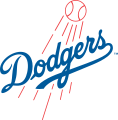 Current logo using "Dodgers" Script |
 Los Angeles Dodgers Script on Dodger Blue |
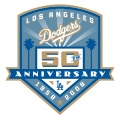 50th anniversary logo. |
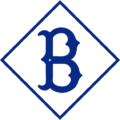 Brooklyn Dodgers Dodgers logo in the 1910s |
Achievements
Baseball Hall of Famers
| Los Angeles Dodgers Hall of Famers | ||||||||||||||||||||||||||||||||||||
|---|---|---|---|---|---|---|---|---|---|---|---|---|---|---|---|---|---|---|---|---|---|---|---|---|---|---|---|---|---|---|---|---|---|---|---|---|
| Affiliation according to the National Baseball Hall of Fame and Museum | ||||||||||||||||||||||||||||||||||||
|
Ford C. Frick Award recipients
Names in bold received the award based primarily on their work as Dodgers broadcasters.
- Red Barber
- Ernie Harwell
- Jaime Jarrin
- Vin Scully
* Played as Dodgers
Retired numbers
Pee Wee Reese SS, Coach July 1, 1984 |
 Tommy Lasorda P, MGR, GM Aug 15, 1997 |
Duke Snider OF July 6, 1980 |
Jim Gilliam 2B, 3B, Coach Oct 10, 1978 |
Don Sutton P Aug 14, 1998 |
Walter Alston MGR June 5, 1977 |
Sandy Koufax P June 4, 1972 |
Roy Campanella C June 4, 1972 |
Jackie Robinson 2B June 4, 1972 |
Don Drysdale P July 1, 1984 |
Since 1997, Robinson's #42 has been retired throughout Major League Baseball in honor of his breaking the color barrier in 1947. Robinson is the only major league baseball player to have this honor bestowed upon him. He spent his entire career with the Dodgers, who retired his number in 1972.
Because the MLB decided to grandfather the use of the number 42 out of the game, New York Yankees closer Mariano Rivera still wears the number as he is the only active player who wore the number before it was retired across all of Major League Baseball.
Koufax, Campanella, and Robinson were the first Dodgers to have their numbers retired. They were all retired in a ceremony at Dodger Stadium on June 4, 1972.
Gilliam died suddenly in 1978 at the age of 49, after a 28-year career with the Dodgers organization. The Dodgers retired his number two days after his death, prior to Game 1 of the 1978 World Series, making him the only non-Hall-of-Famer to have his number retired by the Dodgers.
The Dodgers have not issued #34 since the departure of Fernando Valenzuela in 1991, although it has not been officially retired. Steve Garvey's #6 was not reissued for 19 years until it was given to Dante Bichette in spring training of 2002 and was not worn during a regular season game until Jolbert Cabrera wore it in 2003.
Awards
Team records
Personnel
Current roster
| 40-man roster | Spring Training non-roster invitees |
Coaches/Other | |||||||
|
Pitchers
|
Catchers
Infielders
Outfielders
|
Pitchers
Catchers
Infielders
Outfielders
|
Manager
Coaches
60-day disabled list
* Not on active roster |
||||||
Presidents
- Charlie Byrne 1883–1897
- Charles Ebbets 1898–1925
- Edward McKeever 1925–1925 (interim)
- Wilbert Robinson 1925–1929
- Frank B. York 1930–1932
- Stephen McKeever 1933–1938
- Larry MacPhail 1939–1942
- Branch Rickey 1943–1950
- Walter O'Malley 1950–1970
- Peter O'Malley 1970–1997
- Bob Graziano 1998–2004
- Jamie McCourt 2004–2009
- Dennis Mannion 2009–present
Managers
Since 1884, the Dodgers have used a total of 29 Managers. Joe Torre, the current Manager of the Dodgers, has held the position since 2008.
The managers of the Los Angeles Dodgers (1958–present) are as follows:
- Walter Alston (1958–1976) (in Brooklyn since 1954)
- Tommy Lasorda (1976–1996)
- Bill Russell (1996–1998)
- Glenn Hoffman (1998)
- Davey Johnson (1999–2000)
- Jim Tracy (2001–2005)
- Grady Little (2006–2007)
- Joe Torre (2008–present)
General Managers
- Larry MacPhail (1938–1942)
- Branch Rickey (1943–1950)
- Buzzie Bavasi (1950–1968)
- Fresco Thompson (1968)
- Al Campanis (1968–1987)
- Fred Claire (1987–1998)
- Tommy Lasorda (1998)
- Kevin Malone (1999–2001)
- Dave Wallace (2001)
- Dan Evans (2001–2004)
- Paul DePodesta (2004–2005)
- Ned Colletti (2005–present)
Public address announcers
From the Dodgers' move to Los Angeles from Brooklyn in 1958, the Dodgers employed a handful of well-known public address announcers; the most famous of which was John Ramsey, who served as the PA voice of the Dodgers from 1958 until his retirement in 1982; as well as announcing at other venerable Los Angeles venues, including the Los Angeles Memorial Coliseum and Sports Arena, and the Forum. Ramsey died in 1990.
Packer and Arbogast were emulators of John Ramsey, using the same style of announcing Ramsey was famous for. Arbogast won the job on the day that Ramsey died in 1989, by doing a verbatim imitation of Ramsey's opening and closing remarks that were standard at each game.
The current Dodgers public address announcer is Eric Smith.
Other
Dick Williams – who played for the Dodgers from 1951–54 and again in 1956 – was inducted as a manager having never managed the Dodgers.
Vin Scully is permanently honored in the Hall's "Scribes & Mikemen" exhibit as a result of winning the Ford C. Frick Award in 1982. As with all Frick Award recipients, he is not officially considered an inducted member of the Hall of Fame.
Sue Falsone is first female physical therapist in Major League baseball.
Minor league affiliations
| Level | Team | League | Location |
|---|---|---|---|
| AAA | Albuquerque Isotopes | Pacific Coast League | Albuquerque, NM |
| AA | Chattanooga Lookouts | Southern League | Chattanooga, TN |
| Advanced A | Inland Empire 66ers of San Bernardino | California League | San Bernardino, CA |
| A | Great Lakes Loons | Midwest League | Midland, MI |
| Rookie | Ogden Raptors | Pioneer League | Ogden, UT |
| AZL Dodgers | Arizona League | Phoenix, AZ | |
| Santo Domingo Dodgers | Dominican Summer League | Santo Domingo, Dominican Republic |
Minor league rosters
Further reading
- Red Barber, Rhubarb in the Catbird Seat
- Stanley Cohen, Dodgers! The First 100 Years
- Robert W. Creamer, Stengel: His Life and Times
- D'Agostino, Dennis; Bonnie Crosby (2007). Through a Blue Lens: The Brooklyn Dodgers Photographs of Barney Stein, 1937–1957. Triumph Books. ISBN 1572439521.
- Steve Delsohn, True Blue: The Dramatic History of the Los Angeles Dodgers, Told By the Men Who Lived It
- Carl Erskine and Vin Scully, Tales From the Dodger Dugout: Extra Innings
- Harvey Froemmer, New York City Baseball
- Steve Garvey, "My Bat Boy Days: Lessons I Learned from the Boys of Summer"
- Cliff Gewecke, Day by Day in Dodgers History
- Andrew Goldblatt, The Giants and the Dodgers: Four Cities, Two Teams, One Rivalry
- Richard Goldstein, Superstars and Screwballs: 100 Years of Brooklyn Baseball
- Peter Golenbock, Bums: An Oral History of the Brooklyn Dodgers
- Doris Kearns Goodwin, Wait Till Next Year: A Memoir
- Frank Graham, The Brooklyn Dodgers: An Informal History
- Orel Hershiser with Jerry B. Jenkins, Out Of The Blue
- Donald Honig, The Los Angeles Dodgers: Their First Quarter Century
- Roger Kahn, The Boys of Summer
- Roger Kahn, The Era 1947–1957: When the Yankees, the Giants and the Dodgers Ruled the World
- Mark Langill, The Los Angeles Dodgers
- Tommy Lasorda with David Fisher, The Artful Dodger
- Jane Leavy, Sandy Koufax: A Lefty's Legacy
- Joseph McCauley, Ebbets Field: Brooklyn's Baseball Shrine
- William McNeil, The Dodgers Encyclopedia
- Tom Meany (editor), The Artful Dodgers
- Andrew Paul Mele, A Brooklyn Dodgers Reader
- John J. Monteleone (editor), Branch Rickey's Little Blue Book
- Thomas Oliphant, Praying for Gil Hodges: A Memoir of the 1955 World Series and One Family's Love of the Brooklyn Dodgers
- David Plaut, Chasing October: The Dodgers-Giants Pennant Race of 1962
- Carl E. Prince, Brooklyn's Dodgers: The Bums, The Borough and The Best of Baseball
- Jackie Robinson, I Never Had It Made
- Gene Schoor, The Complete Dodgers Record Book
- Gene Schoor, The Pee Wee Reese Story
- Duke Snider with Bill Gilbert, The Duke of Flatbush
- Michael Shapiro, The Last Good Season: Brooklyn, The Dodgers, and Their Final Pennant Race Together
- Glen Stout, The Dodgers: 120 Years of Dodgers Baseball
- Neil J. Sullivan, The Dodgers Move West
- Jules Tygiel, Baseball's Great Experiment: Jackie Robinson and His Legacy
- John Weaver, Los Angeles: The Enormous Village, 1781–1981
See also
- All-Time roster
- List of Los Angeles Dodgers seasons
- Dodger Dog
- Dodgers-Giants Rivalry
- Dodgers award winners and league leaders
- Dodgers statistical records and milestone achievements
- List of Los Angeles Dodgers broadcasters
- List of Los Angeles Dodgers minor league affiliates
References
- ↑ 1.0 1.1 "Dressed to the Nines uniform database". National Baseball Hall of Fame. http://exhibits.baseballhalloffame.org/dressed_to_the_nines/uniforms.asp?league=NL&city=Brooklyn&lowYear=1930&highYear=1940&sort=year&increment=9. Retrieved 2008-10-08.
- ↑ 2.0 2.1 Bernado, Leonard; Weiss, Jennifer (2006). Brooklyn By Name: From Bedford-Stuyvesant to Flatbush Avenue, And From Ebbetts Field To Williamsburg. New York: New York University Press. p. 81.
- ↑ "Dodgers Timeline". Los Angeles Dodgers. http://losangeles.dodgers.mlb.com/la/history/timeline07.jsp. Retrieved 2008-09-22.
- ↑ "Branch Rickey, 83, Dies in Missouri". The New York Times. http://www.nytimes.com/learning/general/onthisday/bday/1220.html. Retrieved 2008-12-29.
- ↑ "Los Angeles Dodgers Baseball". 2006. http://www.mlb-tickets.net/los-angeles-dodgers.html. Retrieved 2008-09-22.
- ↑ 6.0 6.1 Link text
- ↑ "Dodgers Timeline". Los Angeles Dodgers. http://losangeles.dodgers.mlb.com/la/history/timeline01.jsp. Retrieved 2008-09-22.
- ↑ "Brooklyn Ball Parks". BrooklynBallParks.com. http://www.covehurst.net/ddyte/brooklyn/dodgers.html. Retrieved 2008-10-09.
- ↑ "Buccaneers Rout Sleepy Superbas" (PDF). New York Times. http://query.nytimes.com/mem/archive-free/pdf?res=9E04EFDA1F31E733A05757C1A96F9C946796D6CF. Retrieved 2008-10-08.
- ↑ "Buccaneers Take Last From Robins" (PDF). New York Times. http://query.nytimes.com/mem/archive-free/pdf?res=9C00E3DA103BEE3ABC4152DFB3668383609EDE. Retrieved 2008-10-08.
- ↑ http://commons.wikimedia.org/wiki/File:1920_World_Series_program.jpg
- ↑ , Brooklyn Dodgers Uniform History
- ↑ Baxter, Kevin (April 16, 2008). "Dodgers lead the league in Asian players". Los Angeles Times. http://www.latimes.com/sports/la-sp-dodrep17apr17,1,930146.story. Retrieved 2008-04-17.
- ↑ "Ballparks of Baseball: MLB Attendance". http://www.ballparksofbaseball.com/attendance.htm.
- ↑ Jayson Addcox (July 4, 2007). "Dodgers surpass attendance milestone". MLB.com. http://mlb.mlb.com/news/article.jsp?ymd=20070703&content_id=2064843&vkey=news_mlb&fext=.jsp&c_id=mlb. Retrieved 2008-02-15.
- ↑ "MLB Attendance - Major League Baseball Attendance - ESPN". http://espn.go.com/mlb/attendance.
- ↑ 17.0 17.1 17.2 17.3 17.4 "Vin Scully Retrospective". Los Angeles Dodgers. http://losangeles.dodgers.mlb.com/la/history/vin_scully_tribute/career_highlights.jsp. Retrieved 2009-02-12.
- ↑ Smith, Claire (July 7, 1993). "Dodgers' Death Brings Out the Best". New York Times. http://query.nytimes.com/gst/fullpage.html?res=9F0CE5DF1031F934A35754C0A965958260&sec=&spon=&pagewanted=1. Retrieved 2009-02-26.
- ↑ 19.0 19.1 19.2 Pucin, Diane (December 13, 2008). "Charley Steiner will do radio only for the Dodgers". Los Angeles Dodgers. http://www.latimes.com/sports/baseball/mlb/la-sp-media13-2008dec13,0,6150118.story. Retrieved 2009-02-12.
- ↑ KABC-TV:Dodger Stadium Debuts New Parking Plan Mar. 29, 2007 Retrieved April 8, 2007
External links
- Los Angeles Dodgers official website
- Los Angeles Team Building - Dodger's Mentoring
- LA Dodgers Tickets
- Los Angeles Dodgers Baseball Reference
- The Hardball Times Article on the 1960s Los Angeles Dodgers in The Hardball Times.
|
|||||||||||||||||||||||||||||||||||||||||||||||||||||||||||||||||||||||||||||||||||||
|
|||||||||||||||||||||||||||||||||||||||||||||||||||||||||||||||||||||||||||||||||||||||||||||||||||||||||||||||||||||||||||||||||||||||||||||||||||||||||||||||||||||||||||||||||||||||||||||||||||||||||||||||||||||||||||||||||||||||||||||||||||||||||||||||||||||
